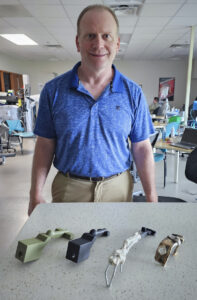
Courtesy Story
Blanchfield Army Community Hospital
Fort Campbell hosts a unique Army unit whose mission is to interpret real-world problems into innovative solutions.
The EagleWerx Applied Tactical Innovation Center is the central point of connection for Warfighters and partners to learn, research, innovate, build, and explore new ideas to solve tactical problems. The ATIC provides the resources and network to empower Warfighter-centered innovation to increase readiness to win the future fight.
1st Lt. Jacob Denton, Staff Sgt. Austin Lehmann, and Spc. Lance Lee are three EagleWerx Soldiers making new ideas come to life.
“Our workload is increasing every month. Innovation is a priority for all networks from the lowest ranking Private up to the Commanding General,” says Lehmann.
Blanchfield Army Community Hospital took this challenge and worked closely with the EagleWerx team to design a prototype attachment to better support their care team’s effort to improve patient experiences.
BACH Occupational Therapy Assistant Bill Canull helped innovate a replica weapon charging handle to assist with upper extremity injures in Soldiers returning from forward deployed areas. This allowed Warfighters an improved recovery period and the ability to perform necessary job tasks.
“We had previously used a mockup that was hand made by our department. The one we got back from EagleWerx was much nicer and fit our grip machine perfect,” said Canull.
“We just got through hosting a team of cadets from West Point Academy that were developing a new medical stand for equipment inside a field tent. This will allow them better organization for their medical tools and keep the area clutter free,” said Denton.
A bottom-up approach to known problems can help increase safety for Soldiers, change policy, tactics, or provide cost effective solutions, added Denton.
Lehmann was able to expand on a medical project he’s currently working on, the Android Team Awareness Kit, or ATAK for short. This device utilizes a vitals measuring system the size of a quarter to capture a patient’s heart rate, temperature, and blood oxygen concentration.
Multiple devices can be connected to a central reader and used by a senior medic to monitor or triage patients during a mass casualty event.
“As we transition to large scale combat environment training, there is a need for medics to have the tools that are valuable to them at a more advanced level. Especially when executing prolonged field care,” Lehmann said.
Lee is taking a different route by developing a toolkit commanders can utilize to estimate combat and non-combat injuries.
“This tool will allow information on various injury types, demographics, and environmental data to reach commanders and allow them to make decisions during field exercises or on real world missions. The data fed into the system will provide key analytics based off a variety of factors,”
Lee said.
Lee further expanded on this idea through demonstration. “The development of the toolkit is currently being used by units in the field on Fort Campbell and the data provided opens the possibility of using AI (artificial intelligence) to create predictive models to improve training.”
Not all of the problems require a high-tech solution. The EagleWerx facility mass produces a 3D printed intravenous spear that when used with paracord, allows medics and doctors in the field to hang up to three 1500ml IV bags in the field in absence of IV stands. The added convenience of an oxygen key built into the bottom of the spear allows the medical providers to open or close oxygen tanks being used on patients.
Denton emphasizes that the projects and ideas brought to EagleWerx originate from Soldiers wanting to improve the way they accomplish their missions. The employees and Soldiers assigned to the ATIC help facilitate the ideas into something actionable.
The EagleWerx staff work in conjunction with 101st Airborne Division (Air Assault) and Fort Campbell work on a variety of projects to find innovative solutions to modern military problems both in the Garrison and in a deployed environment.
Soldiers and Fort Campbell civilian personnel at all levels can submit their ideas through the EagleWerx website at https://home.army.mil/campbell/eaglewerx or stop by the ATIC facility at
89 Screaming Eagle Blvd. on Fort Campbell.